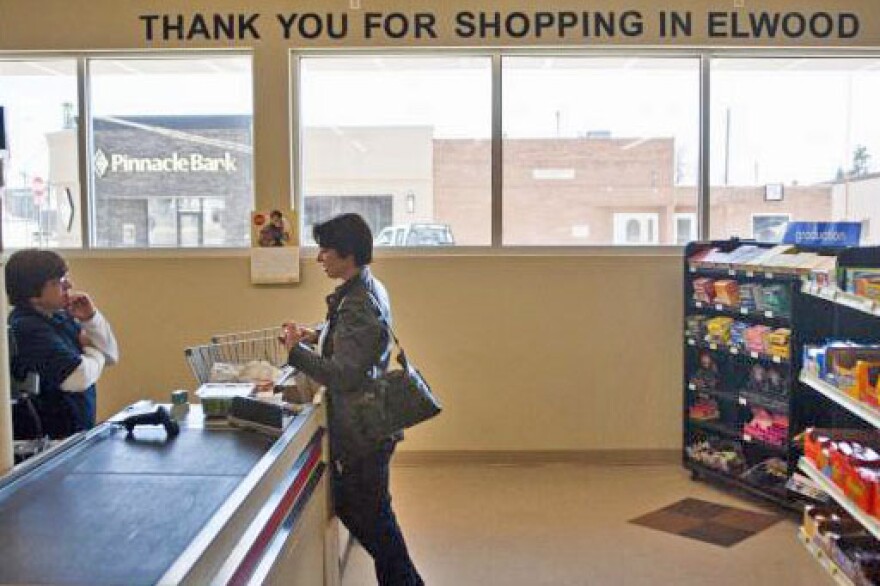The cooperative business model, long a staple of Midwestern agricultural communities, is being adapted to serve a broader range of rural needs.
For example, in the south-central Nebraska town of Elwood — population 700 — there’s a new grocery store.
“I get very emotional almost every time I’m in here, because I’m just so happy to have this store,” said Sharlette Schwenninger, who helped found the cooperative store. The town had been without a grocery store for more than a year.
She said the store was only possible through a community effort because the cost and risk of buying and remodeling the business was too much for any one person. By spreading it across a wide group of people, the rewards also spread across the community.
“Because we were pooling money, we were able to do it right,” Schwenninger said. “That’s kind of what the beauty of a cooperative in a small town is.”
One in five adults over age 15 is a member of a cooperative, according to the United Nations. That's 1 billion people worldwide. And the UN says co-ops will be the fastest-growing business model by the year 2025. But here in the U.S., the number of co-ops has been steadily declining, down 40 percent from 1993.
Basically, co-ops are owned by community members, who pay a membership fee and in return receive financial benefits and voting power. And they come in many forms – everything from a credit union to a marketing co-op. The United Nations says that co-ops will be the fastest-growing business model by the year 2025.
In the U.S., co-op have been rooted in agriculture. One-third of the 100 largest cooperatives in the United States are found in the five-state region of Nebraska, South Dakota, Iowa, Kansas and Missouri, according to the U.S. Department of Agriculture. But the number has been declining. In 1993, 848 ag-related cooperatives operated in the region. By 2007, that number had been cut almost in half.
“What has happened is cooperatives have converged to make them competitive in the world market,” said Ed Woeppel with theNebraskaCooperative Council. “So there’s a lot less cooperatives, but in terms of their importance … I’m not sure it’s any different at all.”
He spread out a map of ag co-ops in Nebraska — it’s covered with what look like neurons; dots show the co-ops’ headquarters, while lines stretch outward in every direction from each dot indicate local branches. The 39 co-ops that belong to the council operate in 352 locations.
But as ag co-ops have gone global, other hyperlocal co-ops – like the Elwood grocery story — have been springing up in greater numbers as rural populations age.
“I think that’s due to people moving out of rural communities,” said Elaine Cranford, with the Nebraska Cooperative Development Center. “Or you’ve got an older population in some of the rural communities, and so the family that owns the diner, or the grocery store, or whatever it may be – the gas station – they want to retire.
“But maybe their children aren’t interested (in taking over the business), or there isn’t somebody else that’s willing to do that. And so the community is more excited about being able to take ownership and keep those services in their town.”
The town of Wolbach, Neb., in north-central Nebraska, was one of those communities.
“We’ve had this idea for a long time … and I read in the paper that this grocery store was for sale, and I called Roy and I said, should we give FROGS a try?” said Mena Sprague with a laugh. Sprague is one of the founding members of FROGS, or First Rural Organic Grocery Store. The co-op opened in January 2011.
But a little more than two years later, it shut down.
“We had high hopes for it, and we’re sad,” Sprague said wistfully, pausing before adding, “but it’s kind of a relief not to have to worry about who’s working, and who’s covering the store.”
FROGS succumbed to two big challenges common to retail co-ops, especially in small towns and rural areas. Their plan relied heavily on volunteerism, but as the town’s initial enthusiasm slowly died off, board members found themselves putting in more and more hours.
There was also the issue of competition with stores in surrounding communities – in particular Grand Island, where much of Wolbach’s population already travels for work.
“And once you’re down there for eight hours, you might as well shop there,” said fellow board member Dave Sprague. “And we cannot compete with Walmart.”
Back in Elwood, Schwenninger said they tried to break habits of shopping in nearby, bigger Lexington by focusing on the economic benefits to the local community.
“We had that problem, to some extent, because we were without a grocery store for a year,” she said. But they told the community that “if they spend money in Elwood, 54 cents of every dollar stays in town. If we shop in Lexington, 15 cents of every dollar stays in Lexington, and none of it comes to Elwood.”
The Elwood co-op has only been open a few months, and there are still challenges. But Schwenninger said she has faith the community will work together to make it successful.
HPPR Note: In Gove, Kansas, population 80, the community formed the Gove Community Improvement Association a number of years ago to have a grocery store. The Association raised money for the project, and area citizens donated labor. As of this date, it is still in operation.






